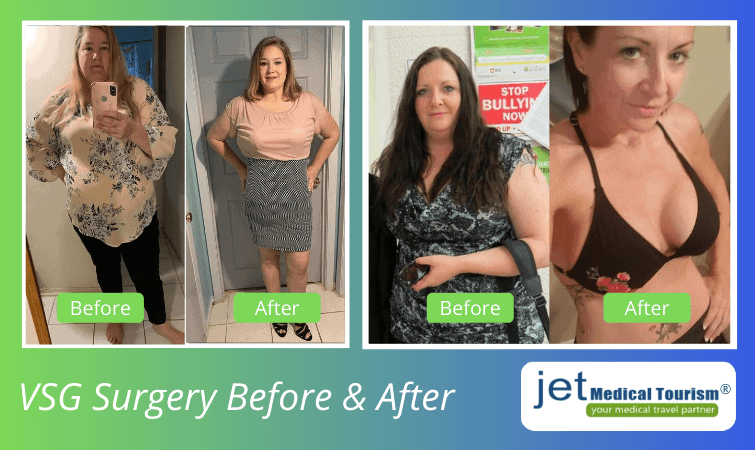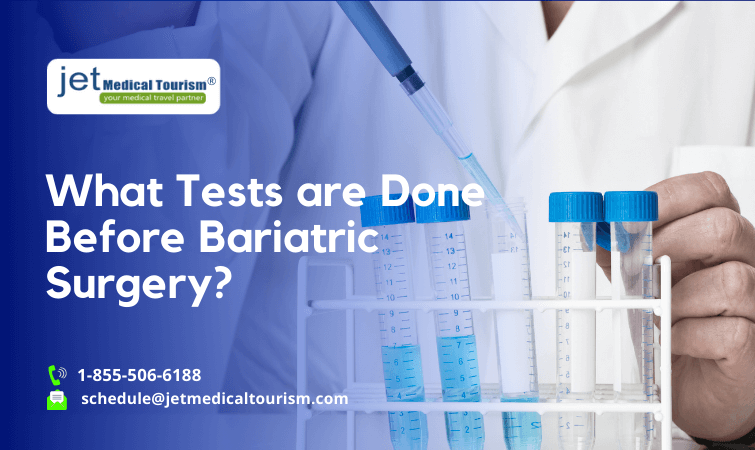What is VSG Surgery?
What is VSG surgery is a common question patients ask when they are considering a weight loss procedure to treat obesity and related conditions. During your initial consultation, your bariatric surgeon will explain to you in detail what is VSG and will determine whether you are a suitable candidate for this surgery.
Vertical sleeve gastrectomy currently ranks as the number one bariatric procedure for patients who want to achieve successful and permanent weight loss.
This restrictive surgery works in two ways. It will reduce the size of your stomach by nearly 80 percent, which will naturally restrict your daily food intake. Secondly, it will cut down the production of ghrelin hunger hormone, in your body. When you ask your surgeon what’s VSG surgery, you should discuss whether they will perform your procedure laparoscopically or as an open surgery. This decision will be made based on your BMI and general health condition.
If you’re seeking an alternative to the high healthcare cost in the United States and Canada, Jet Medical Tourism coordinates innovative and safe VSG Surgery in 2 convenient locations. Don’t wait any longer. Get started today!
What does VSG mean?
VSG stands for vertical sleeve gastrectomy, which is a leading form of weight loss surgery approved by top medical authorities in every country. To understand what is VSG and why it is called vertical sleeve or gastric sleeve, you should know how this procedure is performed. Your bariatric surgeon will remove the outer margin of your stomach to limit your food intake.
Once nearly 80 percent of the stomach is removed, what is left behind is a sleeve of the stomach. This vertical sleeve is roughly the shape and size of a banana. The goal of sleeve gastrectomy procedure is to help you eat less so that you can naturally lose your excess weight. Once the stomach size is reduced, you will feel full faster and will not be able to eat large portions at one time.
During your consultation with your surgeon regarding what’s VSG surgery, you should ask them about the pros and cons of this procedure in comparison to other surgical options. Sleeve surgery is a relatively less invasive procedure, particularly when it is performed laparoscopically. It does not involve reconnecting or rerouting of the intestine. As a result, the risk of complications is minimal in vertical sleeve gastrectomy.
VSG procedure
To understand what is VSG surgery, you should talk to a bariatric surgeon who has recognized expertise in this procedure. Here are some of the key steps involved in a vertical sleeve gastrectomy:
- General Anesthesia: Once you are inside the operating room, a qualified anesthesiologist will place you under general anesthesia. This is the preliminary step before your VSG sleeve procedure can begin.
- Incision Placement: At the time of your discussion about what is VSG, your surgeon will inform about the laparoscopic technique to perform this procedure. This involves placement of small incisions in your abdominal wall.
- Tube Insertion: Through the incisions, your surgeon will insert a Bougie tube in your stomach to measure what should be the size of your new stomach after surgical reduction. The tube will serve as a sizer for this purpose.
- Stomach Stapling: Your bariatric surgeon will apply staples starting from the valve between the small intestine and the stomach. These staples will help to bifurcate your stomach into two parts. The goal is to create a new small stomach.
- Surgical Division: Once the stomach has been divided into two separate parts, your surgeon will remove the larger part (which could be about 80 percent of the original volume). This portion will be decompressed and removed through a small incision.
- Incision Closure: The new stomach will be only about 20 percent of the original stomach size, and will be shaped like a banana. At this point, your surgeon will close the incisions with fine sutures. Very tiny incisions may be left open for natural closure.
When you consult with your weight loss surgeon about what’s VSG surgery, you also discuss how it differs from other bariatric techniques. When you understand all the advantages and downsides of different procedures, you can make a more confident decision about vertical sleeve gastrectomy.
VSG qualification or requirements
Many patients who are suffering from obesity are concerned about how to qualify for VSG surgery. Here are the broad requirements, which should be fulfilled in order to qualify as a candidate for sleeve gastrectomy.
- Your body mass index, BMI for gastric sleeve should be 40 or higher.
- Your BMI should be 35 or higher if you suffer from obesity-related conditions such as diabetes, hypertension, sleep apnea or fatty liver disease.
- You should not have any specific medical condition that disqualifies you for general anesthesia.
- If you smoke, you should be prepared to avoid smoking as directed by your surgeon for a few days before and after your surgery.
- You should be committed to following a pre- and post-op VSG diet and maintain a healthy and active lifestyle in the long run.
If you are wondering about how to qualify for VSG sleeve and whether it is the right surgery for you, speak to the knowledgeable representatives at Jet Medical Tourism® today for the right advice
Pros and Cons of VSG Surgery
When you have a clear idea of what is VSG surgery, and what are the steps involved in the procedure, it is important to understand its pros and cons. Each surgical procedure has its own benefits and limitations, and to make an objective choice, you should be aware of both. A dedicated bariatric surgeon will transparently explain all dimensions of vertical sleeve gastrectomy to you.
What is VSG Surgery – Pros
- Vertical sleeve gastrectomy is less invasive compared to other mainstream bariatric surgery options. Therefore, the post-op discomfort and downtime is reduced.
- The procedure does not involve rerouting of the intestines. As a result, the risk of malabsorption, nutritional deficiencies, and other complications is minimized.
- When the surgery is performed laparoscopically, it will require small incisions. Therefore, post-operative scarring is reduced and recovery is faster.
- Success rate of VSG surgery is very high. Most patients can expect to lose up to 70 percent of their excess weight within the first year of their surgery.
- In addition to weight loss, you can also achieve total elimination or improvement in the symptoms of obesity-related co-morbidities, such as type 2 diabetes, sleep apnea and hypertension.
What is VSG Surgery – Cons
- Vertical sleeve gastrectomy is an irreversible surgery. This means that if at a later stage, you wish to restore the original size of your stomach, it will not be possible.
- The procedure requires you to undergo general anesthesia, which carries its own inherent risks and post-op discomfort. To manage the risk, you should choose a skilled anesthesiologist.
- Although the surgical risks are lower because the procedure is less invasive, some of the intrinsic risks associated with any surgery will still exist.
- The surgery requires a lifelong commitment to diet and exercise. In particular, if you fail to follow the prescribed diet, it may result in dumping syndrome or re-stretching of the stomach.
- In rare cases, the patient may not achieve adequate weight loss or may regain weight quickly despite following the post-op diet. This may require a revision surgery to reduce the stomach further.
VSG cost/price
How much is VSG surgery is an important question to address, especially if you are on a budget. If you do not have insurance coverage for sleeve gastrectomy, your out-of-pocket VSG cost could be prohibitively high in the US or Canada. The average cost of vertical sleeve gastrectomy in these countries may range from $15,000 to $30,000.
However, the good news is that you can choose to have your sleeve gastrectomy surgery in Mexico at some of the world-class hospitals at a small fraction of the cost. Your average VSG cost in Mexico would range from $4,200 to $5,500, when you work with a highly qualified and experienced weight loss surgeon at an accredited Mexico hospital or reputable surgery center.
Does insurance cover VSG surgery
Once you are clear about what is vertical sleeve surgery and how much it will cost, it is important to ask: Does insurance cover VSG surgery? You should talk to your insurance provider in your home country about: (a) whether your policy covers the cost of VSG; and (b) Do you medically qualify for VSG as per the rules of your insurance company?
If you fail to obtain coverage for this weight loss procedure in your home country, then it is important to consider how much is VSG without insurance in Mexico. Your sleeve gastrectomy cost in Mexico would be highly affordable even after accounting for your travel and accommodation costs. Thousands of American and Canadian patients are choosing Mexico every year for safe and cost-effective bariatric surgery in Mexico.
How much is VSG surgery without insurance
VSG surgery without insurance could cost up to $25,000 in the US or Canada. The problem many patients face is that their insurance company may refuse to cover this surgery, even if they have a valid coverage. It’s vital to understand how to qualify for VSG surgery when you are talking to your insurer about coverage.
VSG Surgery Cost in Mexico
In some cases, the patient may have insufficient coverage or their insurance policy may have excluded procedures such as bariatric surgery. In all these situations, it is best to check how much is VSG surgery without insurance in Mexico? You will be able to get the same surgery done in Mexico for less than $5,200 on average with excellent results.
Limitations in the US or Canada
Even when you have proper insurance coverage for vertical sleeve gastrectomy in the US or Canada, the deductibles and co-pay charges may be significantly high. The waiting times may be much longer when you select the insurance route. Moreover, you may not be able to get the weight loss surgeon or hospital of your choice.
Choose Top Surgeons in Mexico
On the other hand, when you find out how much is VSG surgery without insurance in Mexico, the net costs may be much lower even with travel and accommodation. The best part is you can have your procedure with some of the most qualified and experienced bariatric surgeons and leading Mexico hospitals for your surgery.
RELATED: Best Bariatric Surgeons in Mexico
VSG weight loss chart
VSG weight loss chart will describe the estimated progress of your weight reduction following your surgery. To make an informed decision and to mentally and emotionally prepare yourself for your VSG journey, you should know about your VSG average weight loss. Here are the major milestones that will be a part of your VSG expected weight loss chart.
1st Phase: Three Months Post-Surgery
During the first three months after your vertical sleeve gastrectomy, you can expect to lose a substantial amount of excess body weight. The reason is that a good part of your first milestone will involve 100% liquid diet. This will help you achieve rapid weight loss. Even during the latter half of this phase, you will have to follow a stringent diet plan. Almost one-third of your excess weight (about 30 to 35%) may be gone during this phase.
2nd Phase: Six Months Post-Surgery
By the end of your sixth month post-surgery, you would have largely adapted to your new healthy lifestyle. Stay focused on your recommended diet, take your daily nutrition supplements, and do not ignore fitness exercises. The average VSG weight loss by this time would be about 50 to 55 percent of your total excess weight. In other words, you can expect to cross the halfway mark towards your ideal body weight by the end of this phase.
3rd Phase: One Year Post-Surgery
According to the standard VSG weight loss chart, you should have lost about 65 to 70 percent of your excess weight at one year. Clearly, it is time to rejoice because you can see and feel the success of your procedure. You would have come a long way from the time of your initial consultation when you did not even know what is VSG surgery? Apart from weight loss, your symptoms of obesity-related illnesses would have mitigated by this time.
4th Phase: 18 to 24 Months Post-Surgery
The initial euphoria of victory in your obesity battle should not make you less disciplined at this time. A balanced diet and regular exercise should be a part of your everyday life during this phase and beyond. Your VSG expected weight loss chart would indicate that you can achieve your ideal body weight by the end of this phase. This means 100% excess weight loss is possible in about two years provided you stay committed to your diet plan.
RELATED READ: Gastric Sleeve Weight Loss Chart, Timeline
VSG expected weight loss
Your bariatric surgeon will help you form realistic expectations when you ask them about what’s VSG surgery. As a part of your initial consultation, they will educate you about what the surgery can or cannot do for you, and what would be your VSG expected weight loss. Although in general patients can lose about 70 percent of their excess weight in one year, individual results will always vary.
The bottom line is that as long as you remain committed to your surgeon’s advice on diet and exercise, you can expect dramatic and sustainable results. What to expect after VSG surgery is a function of two things: (a) Skills and expertise of your surgeon; and (b) How diligently you maintain your diet and exercise regimen. In ideal conditions, your VSG expected weight loss can be 100 percent of your excess weight in about two years.
VSG diet: What to eat after VSG surgery
One of the critical elements that will determine the long-term success of your weight loss results is your commitment to a balanced diet plan. The nutritionist at your surgeon’s office will explain you in detail what to eat after VSG surgery. The initial post-operative phase will be more sensitive, and you should be prepared to carefully follow the nutritionist’s dietary guidelines.
Even in the long run, your successful body weight maintenance will depend on how diligently you are following your sleeve gastrectomy diet. To broadly understand what is the VSG diet plan you will have to follow, you can review the table provided below. Each individual case is unique, so your specific weight loss diet may be adjusted according to your specific health needs.

RELATED POST: Gastric sleeve diet: An ultimate guide on VSG diet
VSG post op diet
VSG post op diet is the game-changer that will largely determine the long-term success and sustenance of your VSG weight loss. During your discussion about “what is the VSG diet,” your surgeon’s team of nutrition experts will explain to you the diet plan in detail. They will also provide you a vertical sleeve gastrectomy diet chart that will help you systematically follow the plan.
VSG Post Op Diet – Stage 1
Your post-op diet during the first stage after your surgery will include only clear liquids. The duration of this stage may be about one to two weeks, depending on your general health condition, age, extent of surgery, and other factors. The diet may include:
• Clear broth
• No-sugar natural fruit juice
• Decaffeinated tea or coffee
• Jello-O
• Protein shakes or smoothies
• Plenty of water
VSG Post Op Diet – Stage 2
This stage will begin at the end of first or second week, or somewhere in the middle. Your post-op diet at this stage will primarily contain liquids, but also some soft foods. The focus will be more on protein intake in order to aid the healing of incisions. The diet may include:
• Thin soups
• Protein shakes
• Diluted juices (without sugar)
• Greek yogurt
• Applesauce
• Soft noodles in soup
• Pureed tuna or chicken
• Mashed potatoes
• Thin oatmeal
VSG Post Op Diet – Stage 3
The gradual transition to some solid foods will start in the third stage of your VSG sleeve post op diet. You can continue to eat all the foods and beverages that were a part of your stage one and two diet. Protein intake continues to be vital. New foods may include:
• Soft fruits and veggies
• Deli meat
• Soft fish
• Heartier soups
• Eggs
• Cottage cheese
READ THIS TOO: Gastric sleeve diet recipes
VSG Post Op Diet – Stage 4
In about two to three months, your bariatric surgeon and nutritionist may recommend you to return to a solid diet, but with balanced portions. They may encourage you to eat all kinds of solid food slowly and in small portions. But keep avoiding the following foods:
• Processed foods
• Fried, high fat, high sugar foods
• Sweets
• White breads
• Carbonated and caffeinated beverages
• Alcoholic beverages and tobacco
VSG recovery time
Along with what is VSG surgery, you should also ask your surgeon what is the post-op recovery process after your vertical sleeve procedure. In most cases, you can return to your hotel room the same day after your surgery. You should plan to stay for at least one week at the hotel in order to allow for the safe healing of your incisions.
Within one week, most patients are ready to travel and return home. You may want to spend another week at home, but you can resume light activities at this time. Many patients are able to return to their workplace within a week or 10 days after their sleeve gastrectomy. However, take care to avoid any strenuous activities at work for a few days.
In about six weeks after your surgery, you may be able to perform vigorous exercises. Your VSG diet will be a vital part of your recovery plan throughout. If you have any questions or confusion about your dietary guidelines, speak to your nutritionist. In the rare event of any post-operative complications, contact your surgeon promptly and follow their medical advice.
DETAILED ARTICLE: What is the recovery time for gastric sleeve surgery?
VSG before and after photos
VSG ‘before and after’ 3 months will show a visible improvement in your appearance and body weight. Take a look at these VSG before and after photos to know what results you can expect.

VSG journey
Your VSG journey begins from the day you have your first consultation with a bariatric surgeon and they approve your candidacy for vertical sleeve gastrectomy. A million questions will run through your mind at this time: what is VSG, how much is VSG surgery, and what to expect after VSG surgery. Your surgeon may present VSG before and after photos of past patients to reassure you about the kind of results you can expect.
Pre-operative Phase
While you are getting ready to embark on your VSG weight loss journey, your surgeon will suggest you a few preparatory steps. You can start focusing on controlling your diet, and perform mild physical activities to be fit for the surgery. Before your procedure, you will be put on a pre-op liquid diet, which is a vital part of your surgery plan. Feel free to ask questions from your surgeon during the pre-op phase, clear all your doubts, and enter confidently into the surgery room.
Surgery Phase
Your surgery date is probably going to be the most important date in your life. It is the red letter day in your VSG journey, which will change your life. There is no looking back after this, and you will start winning your battle against obesity for good. Your bariatric surgeon will put you at ease, and will perform your procedure while you are in deep sleep with anesthesia. After your surgery, you may be able to leave the hospital the same day or the next day.
Recovery Phase
You will need plenty of rest for about one week post-surgery before you are ready to return to your normal routine. You will have to follow a specific VSG post-op diet plan during the first few months. As your healing progresses over several days and weeks, you can gradually increase your activities. Within a few months, you will be ready to hit the gym. Your body will feel lighter and healthier with each passing month, and your obesity-related medical conditions will progressively improve.
The Golden Phase of Life
By the end of first year in your VSG journey, you would have lost almost 70 percent of your excess weight. You would be well on your way to an ideal body weight. Your self-confidence will reach a new level, people will look at you with envy and admiration, and you will be on top of the world. Wear the clothes you want, play the sports of your choice. Your success will reflect in your personal relationships and professional performance. This is the golden phase of your life.
VSG results: what to expect after VSG surgery
Vertical sleeve gastrectomy is a life-altering procedure that will not only transform your body and health, but also prove beneficial for your psychological, emotional, and social well-being. Here is what to expect after VSG surgery from an experienced bariatric surgeon in Mexico:
- You may lose up to 70 percent of your excess body weight within the first year.
- Depending on your long-term diet and fitness regimen, you may achieve your ideal body weight in 18 to 24 months.
- Symptoms of your underlying medical conditions such as diabetes, hypertension, sleep apnea, PCOS, and heart disease may subside or completely disappear.
- You will feel more energized and can actively participate in vigorous physical exercises, sports, swimming, and other outdoor activities.
- You can wear any type of clothes of your choice without feeling self-conscious, and feel proud of your new body image.
- Your self-confidence and zest for life will dramatically improve, which may positively reflect on your professional performance as well as personal relationships.
YOU MIGHT ALSO LIKE: Gastric sleeve results: Expected weight loss after VSG surgery
VSG surgery in Mexico: Is it safe?
What’s VSG surgery safety profile is another important issue to be addressed before you decide to go ahead with this procedure. Over the last one decade, Mexico has emerged as the world’s leading weight loss surgery tourism destination. Major cities in the country have developed state of the art hospitals and bariatric centers that are accredited by the government of Mexico.
Some of the Mexico hospitals also have JCI accreditation, which is the gold standard in the US for hospital safety. Bariatric surgeons in Mexico are highly skilled, trained, and experienced in procedures such as VSG sleeve surgery. The key to your safety and success in this procedure in Mexico lies in your choice of a reliable medical tourism provider.
Jet Medical Tourism® has assisted patients in the US and Canada to achieve their weight loss goals with safe and affordable VSG surgery in Mexico. Jet Medical Tourism® works with the most reputable bariatric surgeons who have an outstanding track record of success in sleeve gastrectomy. You can expect safe, predictable, and healthy outcomes that will sustain for the long-term after your surgery.
DETAILED POST IS HERE: Is gastric sleeve (VSG) safe?
Tijuana VSG surgery
Tijuana in Mexico has emerged as one of the world’s top centers for VSG surgery medical tourism. With its close proximity to the US, Tijuana not only offers convenience of travel, but also a rich similarity of culture as a border town. Tijuana VSG surgery cost is a small fraction of what you may otherwise have to shell out in the US or Canada.
Experienced VSG Sleeve Surgeons
The bariatric surgeons in Tijuana, Mexico are among the most qualified and experienced medical professionals in the country. Many of the surgeons have performed hundreds or even thousands of VSG surgery and other bariatric procedures. They have an exceptional track record of success and are well-versed with the latest surgical techniques to perform these procedures.
Full-Service Hospitals and Clinics
Tijuana is home to some of the most advanced full-service hospitals as well as bariatric clinics that are fully equipped for vertical sleeve gastrectomy. The surgical equipment at the hospital is state of the art and the centers are fully geared to handle medical tourists from the US and Canada. Doctors for multiple specialties are available in-house as well as best-in-class lab testing facilities are also available.
Personalized Care and Hospitality
One of the best advantages of Tijuana VSG surgery is that you can expect to receive personalized care and hospitality at every step. Unlike in the US or Canada, your VSG surgeon in Tijuana will be always accessible to you and will give you exclusive attention. They will take the time to understand your unique needs, and provide you customized surgical solutions for your vertical sleeve gastrectomy.
READ THIS: Is Tijuana safe? Travel for tourists
How to get VSG surgery
Once you are clear about what is vertical sleeve gastrectomy and you are ready to go ahead with it, you can follow these five simple steps to get VSG surgery in Mexico.
- Step 1: Visit the Jet Medical Tourism® website to learn about their expertise for Mexico bariatric surgery procedures. Check out their patient testimonials, VSG before and after photos, and their affiliations with prominent hospitals, clinics and weight loss surgeons in Mexico.
- Step 2: Call the caring and compassionate Jet Medical Tourism® representatives to know how they can help you learn more about what’s VSG surgery. Ask them about the kind of services and support they can provide you regarding your proposed bariatric surgery in Mexico.
- Step 3: If the preliminary discussion is encouraging for you, and you are willing to consider the option of medical tourism in Mexico, it is time for a free consultation. Simply request Jet Medical Tourism® to set up a virtual consultation for you with a top VSG surgeon in Mexico.
- Step 4: Be frank with your surgeon during the consultation and ask as many questions as you want to clear all your doubts and concerns. Share your medical history with the surgeon to help them determine your candidacy for sleeve surgery in Mexico.
- Step 5: Make a final review of all your options and evaluate how much is VSG in your home country versus how much it will cost in Mexico. Inform Jet Medical Tourism® about your decision, and start preparing for your life-changing journey to Mexico.
Book an appointment for VSG surgery with Jet Medical Tourism®
Are you ready to learn more about what is VSG surgery in Mexico? At Jet Medical Tourism®, we will be happy to answer all your questions and help you make an informed choice. We are proud of the admiration and trust we receive from our patients, and we will go the extra mile to win your trust too. To schedule a complimentary consultation with one of our top bariatric surgeons in Mexico, give us a call today!




